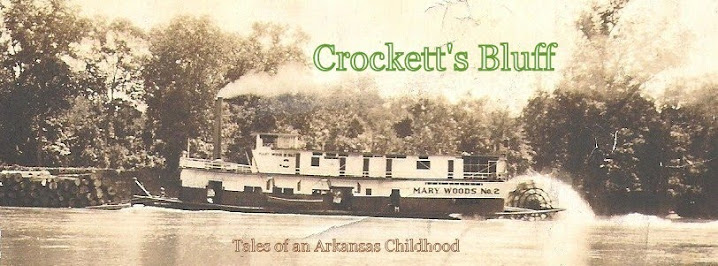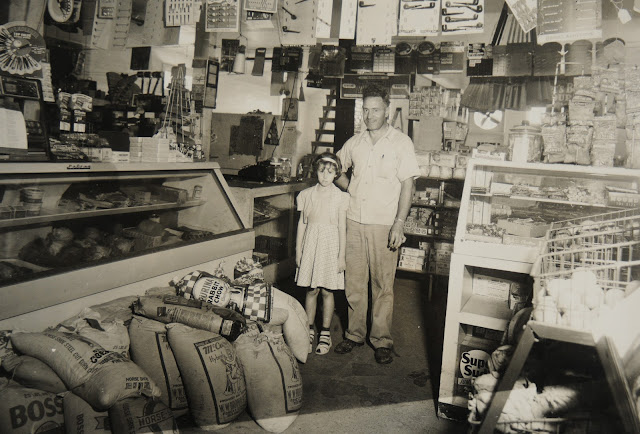The following memoir by Jim Spencer was forwarded to me by Jeanie Marrs Vasseur who lived much of her childhood a stone's throw from the White River in Crockett's Bluff across the river road from Mr. George Gosnell, the subject of this recollection. It was originally published in the Lightnin' Ridge Journal in June 2004.
Through an Old Man’s Eyes
By Jim Spencer
When you leave the pavement and take the winding gravel road that eventually leads you down to the river, it’s not long before you pass a brush-choked old home place on the right. Nothing is left to show of it now, but a friend of mine once lived there.
In the early 1950s, when my family came almost weekly to our cabin on the river, my first order of business upon arrival was to run down the hill to visit Mr. Gosnell. We’d sit on his front step and talk, and after a while Mrs. Gosnell would bring us fresh oatmeal cookies and cold well water. We were great pals despite our slight age difference. I was six at the time. Mr. Gosnell was 101.
He was the only person I ever knew who actually remembered the Civil War. “I was born too late to get to fight in it,” he said regretfully. “I was only 13 when it ended. I did throw a rock at that S.O.B. Sherman one time, though.”
Until Mr. Gosnell was 98, he fished trotlines and limblines in the river. He say ramrod straight in a cane-bottomed chair, paddling up and down the swift river in a one-man cypress boat. They say he was one of the best fishermen on the river, even at 98.
Mr. Gosnell remembered the river and its surrounding forest the way I’d like to be able to remember them, all virgin timber and lousy with deer and bears and panthers and turkeys. He found in me an appreciative audience, and I listened spellbound to many a tale of adventure in the wilderness. I suspect now that a lot of those tales were invented on the spot to thrill a six-year-old boy, but I guess they could have been true. Some of them, anyway.
But their truth was unimportant then, and it still is today. If Mr. Gosnell told a whopper now and then, I figure he earned the right. Anyone tough enough to last for more than a century in an environment as harsh and unforgiving as those untamed bottoms can stretch the truth with every breath if that’s what he wants to do.
But oh, what stories he told: Of Indians traveling up and down the river. Most of whom were friendly but some of whom were not. Of the time they hunt the Union soldiers from the limbs of the gnarled red oak that still stands on a red clay hill above the river. Of the wolves and panthers and bears that came into the very yard in which we sat, killing and carrying off chickens and shoats until they, too, were killed for their trespasses. (The popular version of the soldier-hanging incident says there were nine men hung that day, but Mr. Gosnell maintained it was only five. “Damned if I’ll tell a lie,” he said, “for four miserable Bluecoats.”)
He told me of other things, too, things I could close my eyes and see as he talked, things I will never see first-hand because like Mr. Gosnell, I, too, was born too late. He told me of ducks falling into tiny potholes and sloughs until they blotted out the sky and blanketed the water, returning stubbornly time after time while Mr. Gosnell shot them by the hundreds for the markets in Memphis and Little Rock and St. Louis. He told me of Canada geese sailing into his smoking guns along the gravel bars and sand bars, and he told me of killing them by the dozen. He told me of the infrequent but terrible raids of millions upon millions of passenger pigeons, and of the temporary but near-total devastation they wrought on the mast-laden oaks and pecans along the river. “I hated to see those things come,” he told me. “When they got through, there wasn’t enough food left to fill up a cat squirrel. But they sure were good eatin’.” Those pigeon stories were the most outlandish of all the stories he told me, and I now suspect they were probably the most truthful as well.
He was much too old to take me anywhere, but he described a lot of his favorite places to me. I found some of them when I got old enough to roam those bottoms myself, and I’m still finding some of them today. Every time I do, it gives me a little thrill.
“There’s a little slough back in the woods ‘bout a quarter and a half a quarter southwest of Holly Lake,” he told me one fall morning as we munched cookies on the step. “Used to be a lot of bears back in there on account of there were lots of striped oaks and hackberry trees, and bears like striped oak acorns and hackberries. I never paid much attention, but I expect a fellow could kill a mess of squirrels in there, too, in a dry year when the pecans and white oaks didn’t make.” During a dry year 25 autumns later I recalled what the old man had said, and one morning I walked southwest from Holly Lake. Sure enough, the slough was there. Sure enough, the squirrels were, too.
My oldest friend is long dead now. His old heart finally gave out on him at 104, and they said he kept his wits about him to the very end. I feel privileged to have known him, because he was one of the last of a vanished breed – men who made their way in the wilderness with hook and trap and gun without changing either themselves or the land on which they lived. A century earlier, Mr. Gosnell would have been a mountain man, trapping beaver, fighting Indians, meeting his compatriots at rendezvous each summer. The only thing men like Mr. Gosnell were ill-equipped to handle was the very thing that killed them off, one by one – the inexorable advance of the monster we know as civilization.
“I think I’m about ready to go,” the old man told me the last time I ever saw him. “The summers are hotter than they used to be, and the winters are colder. There ain’t no big trees left, and it’s been 20 years since I seen an eagle. A bear steak would ruin my stomach even if I could find one to eat, and the cold water from the dams has ruint the river. I seen the best of it, and now it’s gone. I might as well be going, too.”
And go he did, not long after. But thanks to him, I “seen the best of it”, too, through the faded blue eyes of a worn-out old man. I can close my eyes and see it still, the way he described it to me 50 years ago, and I can’t walk those bottoms or float that river without remembering something or other he once told me.
And every time I drive past that brushy vacant lot, I can smell fresh oatmeal cookies.
 |
| Clip from its publication in the Pine Bluff Commercial, Feb. 24 1981 |







